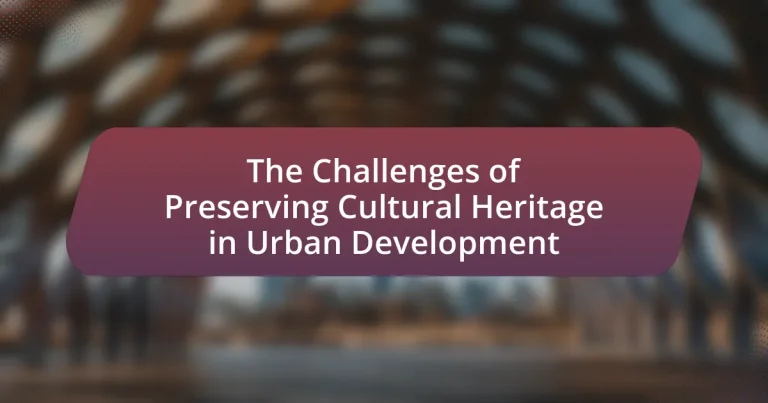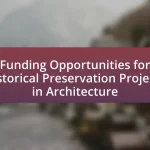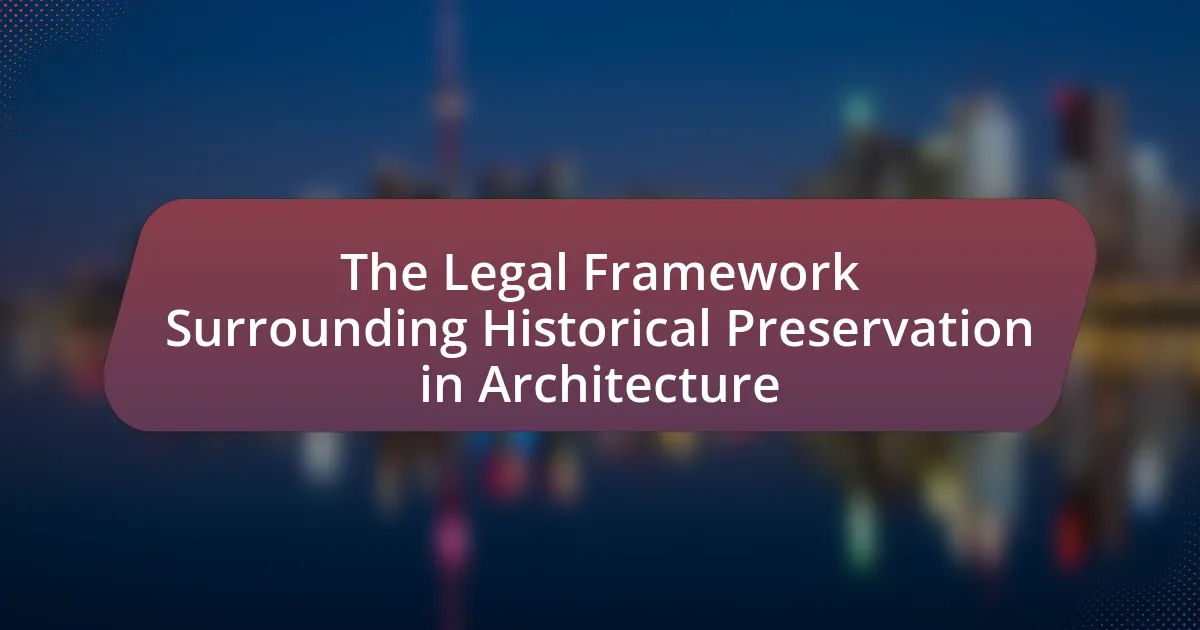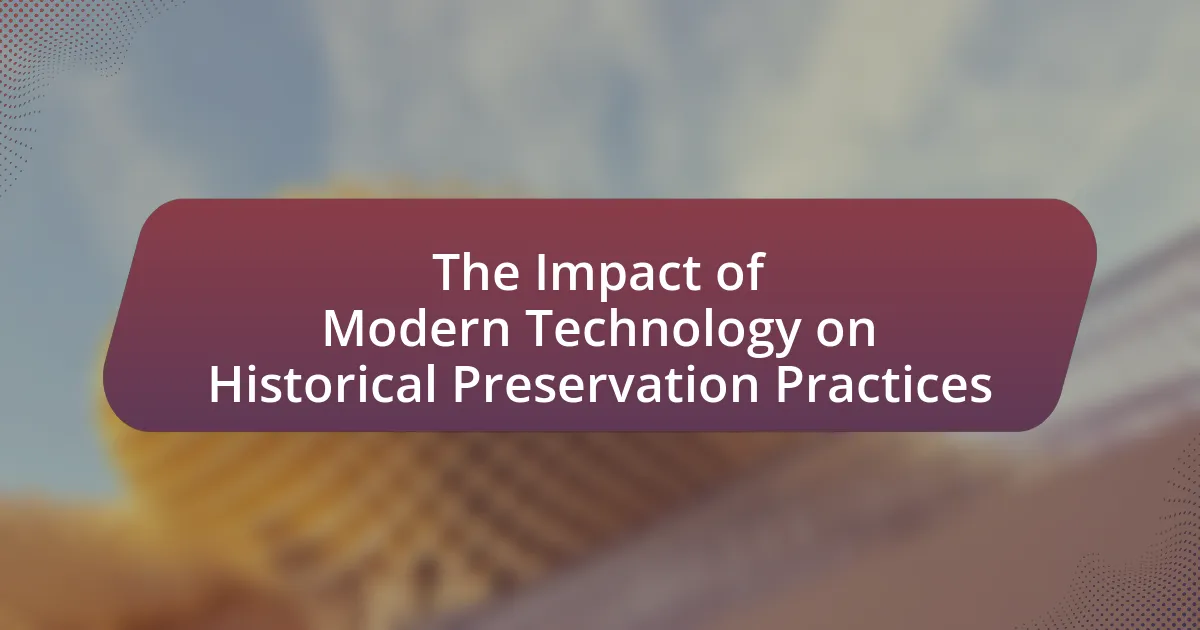The article addresses the challenges of preserving cultural heritage amidst urban development, highlighting key issues such as rapid urbanization, conflicting interests between development and conservation, and inadequate funding for preservation efforts. It examines the impact of urban development on historical sites, traditional neighborhoods, and intangible cultural practices, emphasizing the importance of maintaining community identity and historical continuity. The article also explores the roles of government policies, non-governmental organizations, and community engagement in heritage preservation, while discussing innovative strategies and legal frameworks that can support the integration of cultural heritage into urban planning. Additionally, it considers the effects of climate change on cultural sites and the significance of public awareness and education in advocating for preservation initiatives.
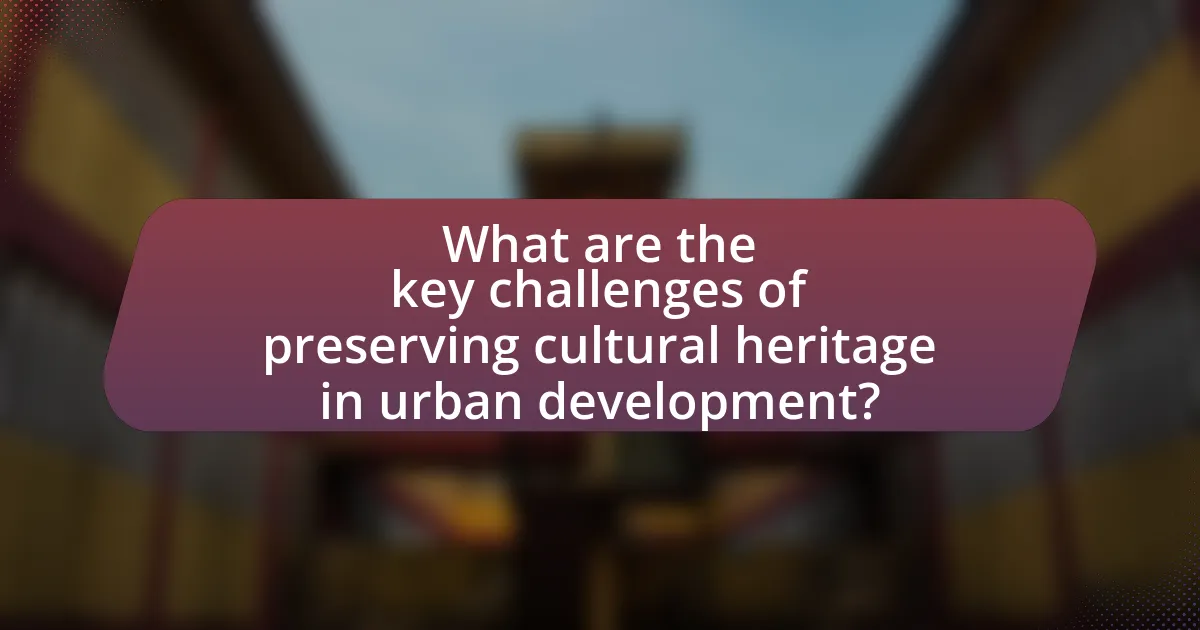
What are the key challenges of preserving cultural heritage in urban development?
The key challenges of preserving cultural heritage in urban development include rapid urbanization, conflicting interests between development and conservation, and inadequate funding for preservation efforts. Rapid urbanization often leads to the demolition of historical sites to make way for new infrastructure, which can erase cultural identity. Conflicting interests arise when developers prioritize economic growth over the preservation of historical significance, leading to decisions that compromise cultural integrity. Additionally, inadequate funding limits the ability of organizations and governments to maintain and restore heritage sites, resulting in deterioration and loss of cultural assets. For instance, UNESCO reports that many cities face the dilemma of balancing modernization with the need to protect their cultural heritage, highlighting the urgency of addressing these challenges.
How does urban development impact cultural heritage preservation?
Urban development significantly impacts cultural heritage preservation by often prioritizing economic growth and infrastructure expansion over the safeguarding of historical sites. This prioritization can lead to the demolition or alteration of culturally significant buildings, as seen in cities like Istanbul, where rapid urbanization has threatened numerous historical landmarks. Additionally, urban development can result in the displacement of communities that maintain cultural practices tied to specific locations, further eroding cultural heritage. Studies indicate that in many urban areas, the loss of heritage sites correlates with increased property values and gentrification, which can marginalize local cultures and histories.
What specific aspects of cultural heritage are most at risk during urban development?
The specific aspects of cultural heritage most at risk during urban development include historical buildings, traditional neighborhoods, and intangible cultural practices. Historical buildings often face demolition or alteration to make way for new infrastructure, leading to the loss of architectural significance and historical context. Traditional neighborhoods may be displaced or transformed, erasing community identity and cultural continuity. Intangible cultural practices, such as local festivals and crafts, can diminish as urbanization disrupts the social fabric and traditional ways of life. According to UNESCO, urban development can lead to the irreversible loss of cultural heritage, emphasizing the need for careful planning and preservation strategies.
How do urbanization trends affect historical sites and monuments?
Urbanization trends significantly impact historical sites and monuments by increasing the risk of their deterioration and displacement. Rapid urban development often leads to construction projects that encroach upon or completely demolish these cultural landmarks, as seen in cities like Istanbul, where historic neighborhoods have been replaced by modern infrastructure. Additionally, urbanization can result in environmental changes, such as pollution and increased foot traffic, which accelerate the degradation of materials used in historical structures. For instance, the acid rain in urban areas has been shown to erode stone and metal surfaces, threatening the integrity of monuments. Furthermore, the prioritization of economic growth over heritage conservation often leads to inadequate funding and attention for preservation efforts, exemplified by the loss of numerous sites in cities undergoing extensive redevelopment.
Why is it important to preserve cultural heritage in urban areas?
Preserving cultural heritage in urban areas is crucial for maintaining community identity and historical continuity. Cultural heritage serves as a tangible link to the past, fostering a sense of belonging among residents and enhancing social cohesion. For instance, UNESCO reports that cities with rich cultural heritage attract tourism, which can significantly boost local economies. Additionally, preserving historical sites and traditions contributes to educational opportunities, allowing future generations to learn about their cultural roots. This preservation is essential not only for economic benefits but also for sustaining the unique character of urban environments amidst rapid development and modernization.
What role does cultural heritage play in community identity?
Cultural heritage plays a crucial role in shaping community identity by providing a sense of belonging and continuity among members. It encompasses traditions, languages, monuments, and practices that define a community’s unique character. For instance, UNESCO recognizes that cultural heritage fosters social cohesion and enhances community pride, as seen in various case studies where local festivals and historical sites strengthen communal ties. This connection to heritage not only influences individual identity but also promotes collective memory, ensuring that the values and narratives of the community are preserved and passed down through generations.
How does cultural heritage contribute to economic development?
Cultural heritage contributes to economic development by attracting tourism, which generates revenue and creates jobs. For instance, UNESCO estimates that cultural heritage tourism accounts for approximately 40% of global tourism, highlighting its significant economic impact. Additionally, preserving cultural sites can enhance local property values and stimulate investment in surrounding areas, as seen in cities like Florence, where heritage preservation has led to increased economic activity and job creation in hospitality and retail sectors.
What are the common conflicts between urban development and cultural heritage preservation?
Common conflicts between urban development and cultural heritage preservation include the prioritization of economic growth over historical significance, leading to the demolition of heritage sites for new construction. Urban development often requires land that is occupied by culturally significant structures, resulting in tensions between developers and preservationists. Additionally, the integration of modern infrastructure can compromise the integrity of historical sites, as seen in cities where new transportation systems disrupt archaeological sites. Studies indicate that urban expansion frequently overlooks the value of cultural heritage, with UNESCO reporting that over 1,000 heritage sites are threatened by urbanization globally.
How do government policies influence these conflicts?
Government policies significantly influence conflicts surrounding the preservation of cultural heritage in urban development by establishing regulations and frameworks that dictate land use, zoning, and heritage protection. For instance, policies that prioritize economic development often lead to the demolition of historic sites to make way for new construction, creating tension between developers and preservationists. In cities like Istanbul, government initiatives to modernize infrastructure have resulted in the loss of numerous historical landmarks, demonstrating how policy decisions can directly impact cultural heritage. Furthermore, the lack of stringent heritage protection laws can exacerbate conflicts, as seen in many urban areas where developers exploit loopholes to bypass preservation efforts.
What are the perspectives of developers versus heritage advocates?
Developers prioritize economic growth and urban development, often advocating for new construction projects that can generate revenue and meet housing demands. They argue that modern infrastructure and housing are essential for accommodating population growth and enhancing city functionality. In contrast, heritage advocates emphasize the importance of preserving historical sites and cultural landmarks, arguing that these elements contribute to community identity and historical continuity. They contend that development should respect and integrate existing heritage, as evidenced by studies showing that heritage tourism can also drive economic benefits. For instance, a report by the National Trust for Historic Preservation highlights that heritage tourism can generate significant revenue while preserving cultural assets.
How can stakeholders collaborate to address these challenges?
Stakeholders can collaborate to address the challenges of preserving cultural heritage in urban development by forming partnerships that integrate diverse perspectives and resources. Collaborative efforts can include joint planning sessions, where urban planners, local governments, cultural organizations, and community members come together to identify heritage sites and develop preservation strategies. For instance, the UNESCO World Heritage Centre emphasizes the importance of stakeholder engagement in its guidelines, highlighting that successful preservation often relies on the active participation of local communities and authorities. By leveraging shared knowledge and resources, stakeholders can create comprehensive policies that balance urban development with cultural heritage conservation, ensuring that both objectives are met effectively.
What innovative strategies exist for balancing urban development and heritage preservation?
Innovative strategies for balancing urban development and heritage preservation include adaptive reuse, community engagement, and the integration of technology. Adaptive reuse involves repurposing historic buildings for modern use, which maintains cultural significance while meeting contemporary needs; for example, transforming old factories into residential lofts preserves architectural heritage while providing housing. Community engagement ensures that local voices are heard in development decisions, fostering a sense of ownership and responsibility towards heritage sites; studies show that involving communities in planning leads to more sustainable outcomes. The integration of technology, such as digital mapping and augmented reality, allows for the visualization of heritage sites within urban plans, helping stakeholders understand the impact of development on cultural assets. These strategies collectively promote a harmonious coexistence of urban growth and heritage conservation.
How can technology aid in the preservation of cultural heritage?
Technology aids in the preservation of cultural heritage by enabling documentation, restoration, and accessibility of historical sites and artifacts. Digital tools such as 3D scanning and modeling allow for accurate representations of cultural assets, which can be used for virtual tours and educational purposes. For instance, UNESCO has utilized digital archiving to preserve endangered sites, ensuring that even if physical structures are damaged, their digital counterparts remain accessible. Additionally, augmented reality applications can enhance visitor experiences at heritage sites, providing interactive learning opportunities that promote awareness and appreciation of cultural history.
What role do community engagement and education play in this process?
Community engagement and education are crucial in preserving cultural heritage during urban development. They foster collaboration between stakeholders, ensuring that local voices and historical contexts are integrated into planning processes. For instance, studies show that projects involving community input are more likely to respect and maintain cultural landmarks, as seen in the successful preservation efforts in cities like Barcelona, where local advocacy groups played a key role in shaping urban policies. Additionally, educational initiatives raise awareness about the importance of cultural heritage, leading to greater public support for preservation efforts. This dual approach not only enhances the effectiveness of preservation strategies but also strengthens community identity and cohesion.
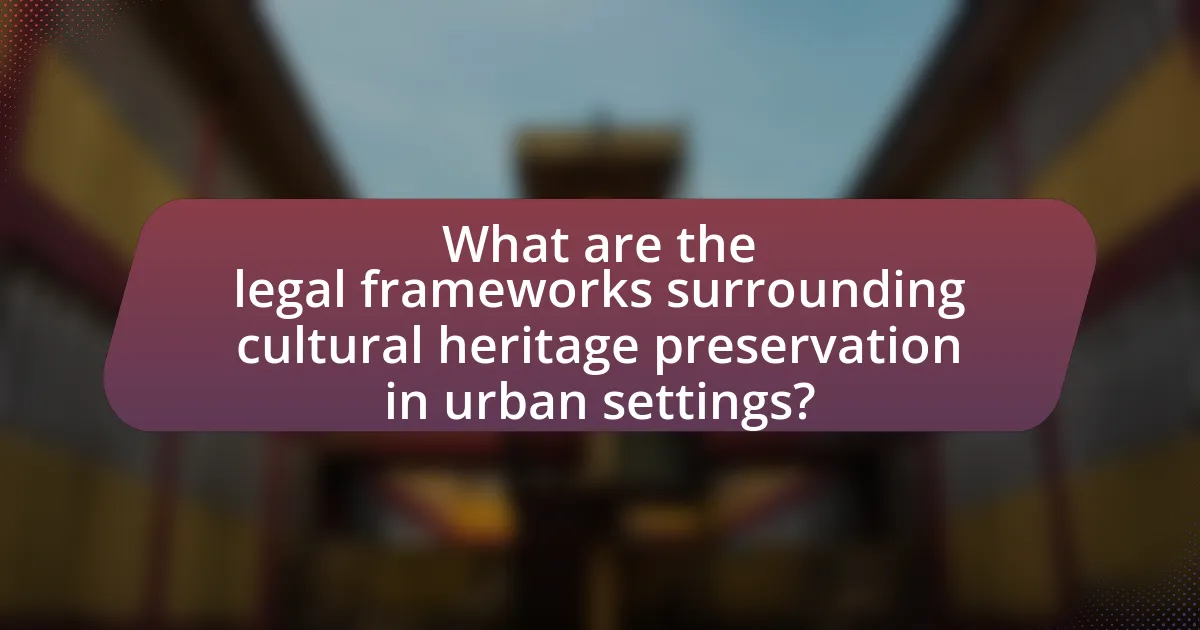
What are the legal frameworks surrounding cultural heritage preservation in urban settings?
Legal frameworks surrounding cultural heritage preservation in urban settings include international treaties, national laws, and local regulations that aim to protect and manage cultural heritage sites. For instance, the UNESCO World Heritage Convention establishes guidelines for the identification and protection of cultural heritage, while national laws, such as the National Historic Preservation Act in the United States, provide mechanisms for the preservation of historic sites. Local regulations often include zoning laws and heritage conservation ordinances that dictate how urban development can occur without compromising cultural assets. These frameworks are essential in balancing urban development with the need to preserve historical and cultural significance, ensuring that urban growth does not lead to the loss of heritage.
What international conventions exist to protect cultural heritage?
The primary international conventions that exist to protect cultural heritage include the UNESCO World Heritage Convention of 1972, the Hague Convention for the Protection of Cultural Property in the Event of Armed Conflict of 1954, and the Convention on the Means of Prohibiting and Preventing the Illicit Import, Export and Transfer of Ownership of Cultural Property of 1970. The UNESCO World Heritage Convention aims to identify, protect, and preserve cultural and natural heritage around the world deemed to be of outstanding value to humanity. The Hague Convention focuses on safeguarding cultural property during armed conflicts, establishing guidelines for the protection of cultural sites. The 1970 Convention addresses the illegal trade of cultural artifacts, promoting the return of stolen cultural property to its country of origin. These conventions collectively form a framework for international cooperation in the preservation of cultural heritage.
How do these conventions influence local laws and practices?
Conventions influence local laws and practices by establishing frameworks that guide the protection and management of cultural heritage. These frameworks often lead to the incorporation of international standards into national legislation, compelling local governments to adapt their laws to align with global norms. For instance, the UNESCO World Heritage Convention encourages countries to create legal protections for sites of cultural significance, which can result in local laws that prioritize heritage conservation over urban development. This alignment is evidenced by the implementation of specific zoning laws and building regulations that restrict alterations to historic sites, ensuring that local practices reflect the values set forth by these conventions.
What are the challenges in enforcing these legal frameworks?
Enforcing legal frameworks for preserving cultural heritage in urban development faces several challenges, including lack of awareness, insufficient resources, and conflicting interests. Many stakeholders, such as developers and local governments, may prioritize economic growth over heritage conservation, leading to inadequate enforcement of existing laws. Additionally, limited funding and personnel for regulatory bodies hinder effective monitoring and compliance. Studies indicate that in cities with rapid urbanization, such as Istanbul, the pressure to develop can result in the neglect of heritage laws, demonstrating the difficulty in balancing development and preservation.
How do local governments approach cultural heritage preservation?
Local governments approach cultural heritage preservation through policies and regulations that aim to protect historical sites and promote community engagement. They often establish heritage conservation programs, which include designating landmarks, creating preservation ordinances, and providing funding for restoration projects. For instance, the National Historic Preservation Act in the United States empowers local governments to identify and protect significant cultural resources, ensuring that urban development does not compromise historical integrity. Additionally, local governments may collaborate with community organizations and stakeholders to raise awareness and foster public participation in preservation efforts, thereby enhancing the cultural landscape while accommodating urban growth.
What policies have been successful in integrating heritage preservation into urban planning?
Successful policies for integrating heritage preservation into urban planning include the implementation of zoning regulations that protect historic districts, the establishment of heritage conservation easements, and the promotion of adaptive reuse of historic buildings. Zoning regulations, such as those seen in cities like Charleston, South Carolina, restrict new developments that could negatively impact the character of historic areas, thereby preserving their cultural significance. Heritage conservation easements, utilized in places like New York City, allow property owners to voluntarily limit development on their properties in exchange for tax benefits, ensuring the preservation of historic sites. Additionally, adaptive reuse policies encourage the transformation of old buildings for modern use, as demonstrated by the conversion of factories into residential lofts in cities like Detroit, which maintains the architectural integrity while meeting contemporary needs. These policies collectively demonstrate effective strategies for harmonizing urban development with heritage preservation.
How do funding and resources affect preservation efforts?
Funding and resources significantly impact preservation efforts by determining the scope and effectiveness of initiatives aimed at protecting cultural heritage. Adequate financial support enables the hiring of skilled professionals, the acquisition of necessary materials, and the implementation of advanced technologies for restoration. For instance, a study by the National Trust for Historic Preservation found that communities with dedicated funding for heritage projects are more successful in maintaining their historical sites, with a reported 30% increase in preservation outcomes compared to those without such funding. Additionally, resources such as grants and public-private partnerships can facilitate community engagement and awareness, further enhancing preservation efforts.
What role do non-governmental organizations play in cultural heritage preservation?
Non-governmental organizations (NGOs) play a crucial role in cultural heritage preservation by advocating for the protection of historical sites and promoting community engagement in heritage conservation. NGOs often mobilize resources, raise awareness, and provide expertise to safeguard cultural assets that may be threatened by urban development. For instance, organizations like the World Monuments Fund have successfully intervened in various projects to protect endangered sites, demonstrating the effectiveness of NGO involvement in preserving cultural heritage. Their efforts often include conducting research, facilitating partnerships, and influencing policy to ensure that cultural heritage is integrated into urban planning processes.
How do NGOs collaborate with local communities and governments?
NGOs collaborate with local communities and governments by engaging in partnerships that leverage resources, knowledge, and local insights to address community needs. These collaborations often involve joint initiatives, where NGOs provide expertise and funding while local communities and governments contribute local knowledge and support for implementation. For instance, NGOs may facilitate workshops to educate communities about cultural heritage preservation, while local governments may offer regulatory support or funding for projects. This synergy enhances the effectiveness of urban development projects, ensuring that cultural heritage is preserved amidst modernization efforts. Evidence of successful collaborations can be seen in various urban development projects worldwide, where NGOs have played a crucial role in advocating for community interests and influencing policy decisions.
What successful case studies illustrate the impact of NGOs on preservation efforts?
Successful case studies illustrating the impact of NGOs on preservation efforts include the work of the Global Heritage Fund in preserving endangered cultural sites, such as the ancient city of Luang Prabang in Laos. This NGO implemented a comprehensive preservation plan that involved local communities, resulting in the restoration of historical buildings and sustainable tourism practices that protect the cultural heritage while benefiting the local economy. Additionally, the World Monuments Fund has successfully advocated for the preservation of the historic center of Florence, Italy, by mobilizing resources and raising awareness about the threats posed by urban development. Their efforts led to significant funding and support for restoration projects, demonstrating the effectiveness of NGO involvement in cultural heritage preservation amidst urban challenges.
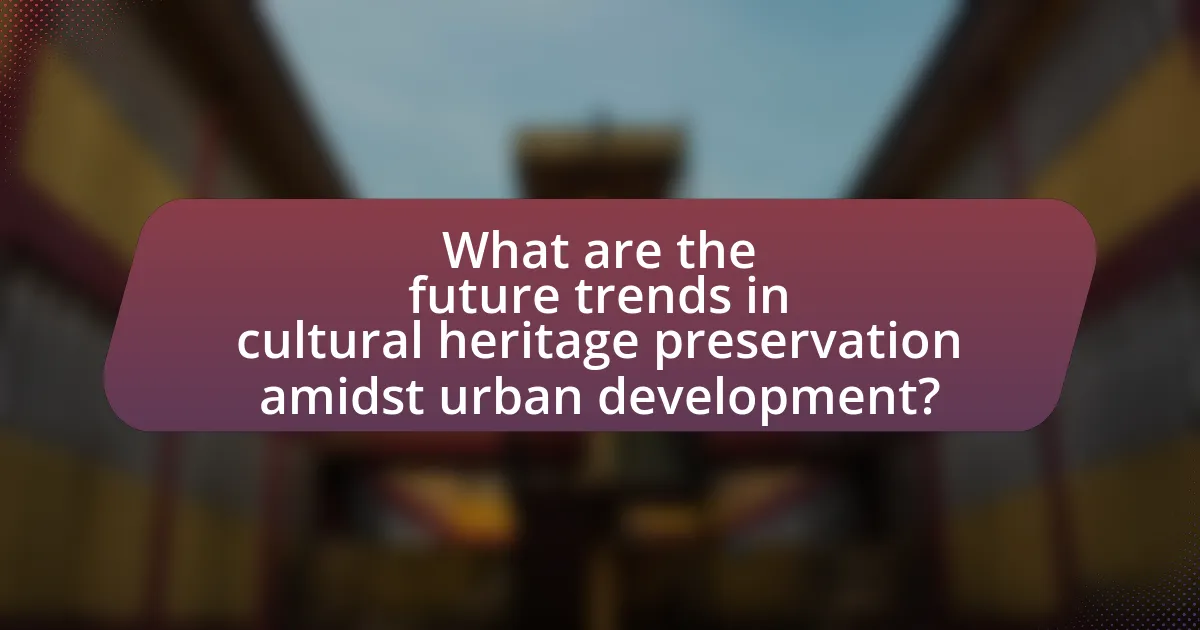
What are the future trends in cultural heritage preservation amidst urban development?
Future trends in cultural heritage preservation amidst urban development include the integration of technology, community engagement, and sustainable practices. The use of digital tools such as 3D modeling and virtual reality allows for the documentation and visualization of heritage sites, making them accessible to a broader audience. Community involvement in preservation efforts fosters a sense of ownership and ensures that local voices are heard in decision-making processes. Additionally, sustainable urban planning practices that prioritize the conservation of historical sites while accommodating modern infrastructure are increasingly being adopted. For instance, cities like Barcelona have implemented policies that balance development with heritage conservation, demonstrating a commitment to preserving cultural identity amidst urban growth.
How is climate change affecting cultural heritage sites in urban areas?
Climate change is adversely affecting cultural heritage sites in urban areas through increased flooding, rising temperatures, and extreme weather events. These environmental changes lead to physical deterioration of structures, loss of artifacts, and damage to historical landscapes. For instance, cities like Venice are experiencing more frequent flooding due to rising sea levels, which threatens its iconic architecture and artworks. Additionally, urban heat islands exacerbate temperature fluctuations, causing materials like stone and mortar to degrade faster. Studies indicate that over 50% of UNESCO World Heritage Sites are at risk from climate change impacts, highlighting the urgency of addressing these challenges in urban development.
What adaptive strategies are being implemented to protect these sites?
Adaptive strategies being implemented to protect cultural heritage sites in urban development include the integration of heritage impact assessments into urban planning processes. These assessments evaluate the potential effects of development on cultural sites, ensuring that preservation measures are prioritized. Additionally, local governments are establishing zoning regulations that restrict construction near significant heritage locations, thereby minimizing risks of damage. Community engagement initiatives are also being employed to raise awareness and involve local populations in preservation efforts, fostering a sense of ownership and responsibility towards cultural heritage. These strategies are supported by international guidelines, such as those from UNESCO, which emphasize the importance of balancing development with heritage conservation.
How can urban planners incorporate sustainability into heritage preservation?
Urban planners can incorporate sustainability into heritage preservation by integrating eco-friendly practices and materials in restoration projects. This approach not only maintains the historical integrity of structures but also reduces environmental impact. For instance, using reclaimed materials and energy-efficient technologies can minimize resource consumption while preserving the aesthetic and cultural significance of heritage sites. Studies show that sustainable practices in urban planning can lead to a 30% reduction in carbon emissions, highlighting the effectiveness of such strategies in balancing development and preservation.
What role does public awareness play in the preservation of cultural heritage?
Public awareness is crucial for the preservation of cultural heritage as it fosters community engagement and support for conservation efforts. When individuals are informed about the significance of cultural heritage, they are more likely to advocate for its protection and participate in preservation initiatives. Studies have shown that communities with high levels of public awareness are more successful in implementing policies that safeguard their cultural assets, as seen in various urban development projects where local advocacy groups have influenced decision-making processes. For instance, the UNESCO World Heritage Centre emphasizes that public involvement is essential for sustainable heritage management, highlighting that informed citizens can effectively challenge detrimental urban development practices that threaten cultural sites.
How can social media and digital platforms enhance public engagement?
Social media and digital platforms enhance public engagement by facilitating real-time communication and interaction between communities and stakeholders. These platforms allow for the dissemination of information regarding cultural heritage initiatives, enabling broader participation in discussions and decision-making processes. For instance, a study by the Pew Research Center found that 69% of adults in the U.S. use social media, which provides a vast audience for sharing updates, gathering feedback, and mobilizing support for cultural preservation efforts. Additionally, digital platforms can host virtual events and forums, making it easier for diverse voices to contribute to the conversation about urban development and heritage preservation.
What educational initiatives are effective in promoting cultural heritage awareness?
Educational initiatives that effectively promote cultural heritage awareness include community-based programs, school curricula focused on local history, and interactive workshops. Community-based programs engage local populations in preserving and celebrating their heritage, fostering a sense of ownership and pride. For instance, the UNESCO World Heritage Education program has successfully implemented educational activities that raise awareness about cultural heritage among youth, demonstrating the impact of structured educational frameworks. School curricula that incorporate local history and cultural studies have been shown to enhance students’ understanding and appreciation of their heritage, as evidenced by programs in various countries that integrate cultural education into standard teaching practices. Interactive workshops, such as those organized by cultural institutions, allow participants to experience heritage firsthand, reinforcing knowledge through practical engagement. These initiatives collectively contribute to a deeper understanding and appreciation of cultural heritage within communities.
What practical steps can communities take to advocate for cultural heritage preservation?
Communities can advocate for cultural heritage preservation by organizing awareness campaigns that educate the public about the importance of local heritage sites. These campaigns can include workshops, social media outreach, and community events that highlight the historical and cultural significance of these sites. For instance, studies show that communities with active heritage advocacy groups, such as the National Trust for Historic Preservation, have successfully influenced local policies to protect cultural landmarks. Additionally, communities can engage in partnerships with local governments to create preservation plans that incorporate community input, ensuring that development projects consider the impact on cultural heritage. This collaborative approach has been proven effective in cities like Charleston, South Carolina, where community involvement led to the establishment of strict preservation regulations.
